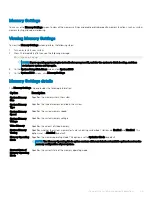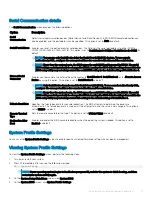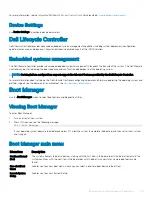
Miscellaneous Settings
You can use the
Miscellaneous Settings
screen to perform specific functions such as updating the asset tag and changing the system
date and time.
Viewing Miscellaneous Settings
To view the
Miscellaneous Settings
screen, perform the following steps:
1
Turn on, or restart your system.
2
Press F2 immediately after you see the following message:
F2 = System Setup
NOTE:
If your operating system begins to load before you press F2, wait for the system to finish booting, and then
restart your system and try again.
3
On the
System Setup Main Menu
screen, click
System BIOS
.
4
On the
System BIOS
screen, click
Miscellaneous Settings
.
Miscellaneous Settings details
The
Miscellaneous Settings
screen provides the following options.
NOTE:
The NX440 system does not support UEFI mode.
Option
Description
System Time
Enables you to set the time on the system.
System Date
Enables you to set the date on the system.
Asset Tag
Specifies the asset tag and enables you to modify it for security and tracking purposes.
Keyboard NumLock
Enables you to set whether the system boots with the NumLock enabled or disabled. This option is set to
On
by
default.
NOTE:
This option does not apply to 84-key keyboards.
F1/F2 Prompt on
Error
Enables or disables the F1/F2 prompt on error. This option is set to
Enabled
by default. The F1/F2 prompt also
includes keyboard errors.
Load Legacy Video
Option ROM
N/A
Dell Wyse P25/P45
BIOS Access
Enables or disables the Dell Wyse P25/P45 BIOS Access. This option is set to
Enabled
by default.
Power Cycle
Request
Enables or disables the Power Cycle Request. This option is set to
None
by default.
iDRAC Settings utility
The iDRAC settings utility is an interface to set up and configure the iDRAC parameters. You can enable or disable various iDRAC
parameters by using the iDRAC settings utility available with iDRAC Enterprise License.
NOTE:
The NX Series systems support only BIOS mode. Do not change the boot mode to UEFI because the system will not load
the appliance OS when in UEFI mode.
48
Pre-operating system management applications















































